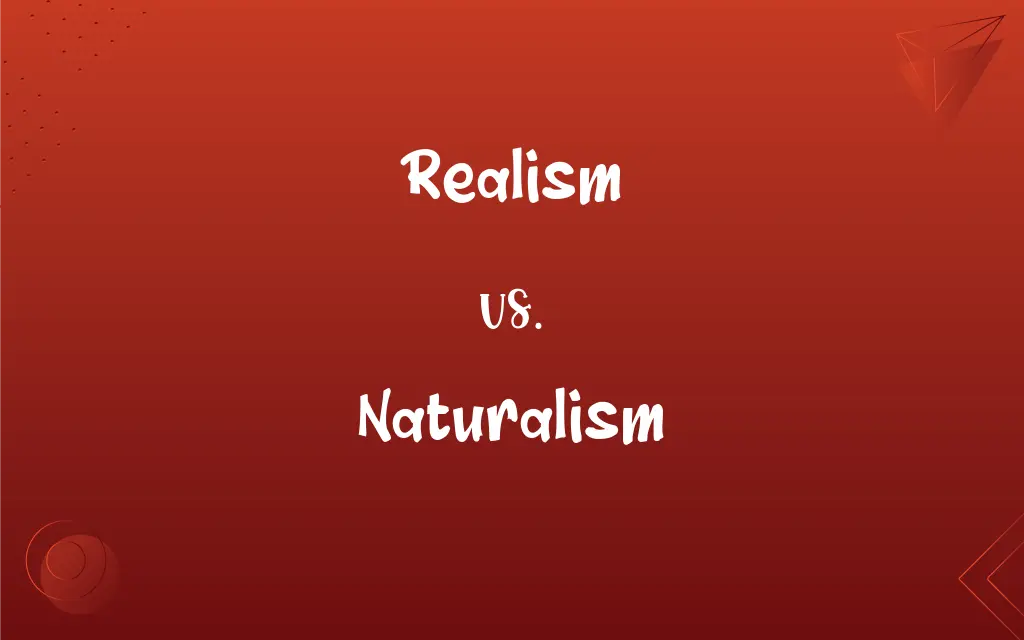Realism vs. Naturalism: What's the Difference?
Edited by Aimie Carlson || By Harlon Moss || Updated on October 7, 2023
Realism focuses on depicting everyday life authentically; naturalism emphasizes the influence of environment and heredity on human behavior.

Key Differences
Realism is an artistic and literary movement that seeks to represent life as it truly is, without artificiality. Naturalism, though similar to realism in representing reality, emphasizes the deterministic role of the environment, biology, and heredity on human behavior.
In the realm of literature, realism might present a slice-of-life story, showcasing the regular experiences and events of individuals. Naturalism, on the other hand, would delve deeper into the underlying forces affecting those individuals, particularly focusing on the darker, uncontrollable elements guiding their actions.
Within the arts, a realist painter would aim to depict a scene or subject with precision and accuracy, capturing its physical essence. A naturalist painter, conversely, might emphasize the environmental conditions and their effects on the subject, showcasing nature's dominance.
Essentially, while realism zeroes in on an objective portrayal of life, naturalism delves into the inevitable forces of nature and biology that shape existence.
Comparison Chart
Focus
Everyday life
Effects of environment and heredity on human behavior
ADVERTISEMENT
Philosophical Underpinning
Depict life as it is
Deterministic outlook, nature and biology shape fate
In Literature
Represents regular experiences and events
Highlights uncontrollable elements guiding actions
In Art
Captures physical essence of subject
Emphasizes environmental conditions and effects on subject
Themes
Daily life, societal issues
Fate, nature's dominance, biological determinism
Realism and Naturalism Definitions
Realism
An artistic or literary method focusing on true representation.
His novel's realism captured the essence of urban life.
ADVERTISEMENT
Naturalism
A style in art or literature that seeks to depict the natural world and life.
The novel's naturalism was evident in its detailed portrayal of forest life.
Realism
The quality or fact of representing a person or thing in a way that is true to life.
The realism of her portrait was uncanny.
Naturalism
A belief that everything arises from natural properties and causes.
Naturalism, as a philosophy, denies the supernatural's existence.
Realism
The view that physical objects exist independently of our perception.
Philosophers debate realism in terms of our understanding of the world.
Naturalism
An emphasis on nature as the force determining human behavior.
The play showcased the principle of naturalism by focusing on environmental influences.
Realism
A disposition toward accepting facts and the physical reality.
His realism kept the group grounded during their brainstorming session.
Naturalism
The doctrine that the world can be understood in scientific terms without recourse to spiritual elements.
His belief in naturalism shaped his approach to scientific inquiry.
Realism
A movement rejecting abstract or romantic treatments.
Realism in the 19th century was a response to Romanticism.
Naturalism
Artistic portrayal focusing on the raw, uncensored conditions of life.
The painting's stark naturalism drew attention to the struggles of the working class.
Realism
An inclination toward literal truth and pragmatism.
Naturalism
The practice of describing precisely the actual circumstances of human life in literature.
Realism
The representation in art or literature of objects, actions, or social conditions as they actually are, without idealization or presentation in abstract form.
Naturalism
The practice of reproducing subjects as precisely as possible in the visual arts.
Realism
The scholastic doctrine, opposed to nominalism, that universals exist independently of their being thought.
Naturalism
A movement or school advocating such precise representation.
FAQs
How does realism treat character development?
Realism focuses on developing complex characters with genuine, authentic emotions and experiences.
What defines naturalism?
Naturalism is a literary movement that applies scientific principles of objectivity and detachment to the study of human beings.
Is realism relevant in contemporary literature?
Yes, realism continues to influence contemporary literature by emphasizing authentic depictions of life and character.
Do modern works still embody naturalism?
Yes, modern works may explore naturalistic themes, examining the influence of environment and heredity on individuals.
When did realism begin?
Realism began in the 19th century as a reaction against romanticism.
Who are prominent realist authors?
Notable realist authors include Gustave Flaubert, Leo Tolstoy, and George Eliot.
What impact did naturalism have on psychology and sociology?
Naturalism influenced the study of human behavior, emphasizing environmental factors and determinism in shaping individuals and societies.
How do realism and naturalism treat fate and free will?
Realism often recognizes an individual's agency, while naturalism is more likely to view characters as subject to deterministic forces beyond their control.
Do realism and naturalism share thematic elements?
Yes, both often explore themes related to the human condition, society, and everyday struggles.
How did realism influence art?
Realism influenced art by prioritizing accuracy, details, and observable reality over idealized depictions.
What is realism?
Realism is a literary and artistic movement emphasizing accurate and detailed depiction of real life.
Is realism limited to literature?
No, realism extends to various art forms, including painting and theatre.
Who are key figures in naturalism?
Émile Zola, Stephen Crane, and Theodore Dreiser are notable naturalistic writers.
How does naturalism perceive human nature?
Naturalism often perceives humans as being shaped by environment, heredity, and chance.
How are realism and naturalism similar?
Both movements aim to accurately portray real life, often focusing on everyday experiences and surroundings.
What differentiates realism from naturalism?
Realism focuses on an accurate depiction of life, while naturalism introduces a more scientific and deterministic perspective on human behavior.
Can you name a prominent realist novel?
"Madame Bovary" by Gustave Flaubert is a seminal work of realism.
When did naturalism originate?
Naturalism originated in the late 19th century, evolving from realism.
Does naturalism focus more on the upper or lower class?
Naturalism commonly explores the lives and struggles of the lower class.
Give an example of a naturalistic work.
"Sister Carrie" by Theodore Dreiser is a notable example of naturalistic literature.
About Author
Written by
Harlon MossHarlon is a seasoned quality moderator and accomplished content writer for Difference Wiki. An alumnus of the prestigious University of California, he earned his degree in Computer Science. Leveraging his academic background, Harlon brings a meticulous and informed perspective to his work, ensuring content accuracy and excellence.
Edited by
Aimie CarlsonAimie Carlson, holding a master's degree in English literature, is a fervent English language enthusiast. She lends her writing talents to Difference Wiki, a prominent website that specializes in comparisons, offering readers insightful analyses that both captivate and inform.































































